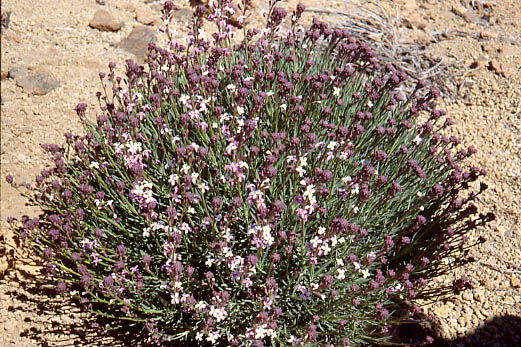- Erysimum
image_caption = Teide wallflower "Erysimum scoparium "
regnum =Plantae
unranked_divisio =Angiosperms
unranked_classis =Eudicots
unranked_ordo =Rosids
ordo =Brassicales
familia =Brassicaceae
genus = "Erysimum"
genus_authority = L.
subdivision_ranks =Species
subdivision = Over 220, see text
synonyms = See text|The
genus "Erysimum" (wallflowers) includes more than 220species , both popular garden plants and many wild forms. They are small, annual, short-lived perennialherb s orsub-shrub s, reaching 10-130 cm tall, with bright yellow to red or pinkflower s produced throughout the spring and summer. One species, "Erysimum semperflorens ", native toMorocco andAlgeria , has white flowers. Wallflowers have t-shapedtrichome s.The genus "
Cheiranthus " is sometimes included herein whole or in part.Distribution
Wallflowers are native to southwest
Asia , theMediterranean region ,Europe ,Macaronesia (IncludingCabo Verde ), andNorth America throughCosta Rica . Many wallflowers are endemic to small areas, such as theTeide wallflower "E. scoparium", endemic to theTeide volcano onTenerife , "E. aetnense " endemic to theEtna volcano inSicily , theFranciscan wallflower "E. franciscanum", endemic to the northernCalifornia coast, theSierra Nevada wallflower "E. nevadense", endemic to the Sierra Nevada of Spain, "E. moranii" fromGuadalupe Island (Mexico), and theendangered Santa Cruz wallflower "E. teretifolium", endemic to the inland sandhills ofSanta Cruz County, California . "Erysimum kykkoticum ", found only onCyprus , is nearlyextinct .Ecology
"Erysimum" species are used as food plants by the
larva e of someLepidoptera (butterfly andmoth ) species including theGarden Carpet ("Xanthorhoe fluctuata"). In addition, some species of weevils, like "Ceutorhynchus chlorophanus ", live inside the fruits feeding on the developing seeds. Many species of beetles, bugs and grasshoppers eat on the leaves and stalks. Somemammal ian herbivores, for example Mule Deer ("Odocoileus hemionus ") in North America, Red Deer ("Cervus elaphus ") in Central Europe, or Spanish Ibex ("Capra pyrenaica ") in the Iberian Peninsula, feed on wallflower flowering and fruiting stalks.Most wallflowers are pollinator-generalists, their flowers being visited by many different species of bees, bee flies, hoverflies, butterflies, beetles, and ants. However, there some specialist species. For example,
Teide wallflower is pollinated almost exclusively by "Anthophora alluadii".elected species
* "Erysimum aetnense " - Etna wallflower
* "Erysimum ammophilum "
* "Erysimum angustatum " - Dawson wallflower
* "Erysimum arenicola " - Cascade wallflower
* "Erysimum asperum "
* "Erysimum baeticum "
* "Erysimum bicolor "
* "Erysimum bonannianum "
* "Erysimum caboverdeanum "
* "Erysimum capitatum " - Sanddune wallflower, Western wallflower
* "Erysimum cazorlense "
* "Erysimum cheiranthoides " - Wormseed wallflower
* "Erysimum cheiri "
* "Erysimum diffusum " - diffuse wallflower
* "Erysimum duriaei "
* "Erysimum durum "
* "Erysimum franciscanum " - Franciscan wallflower
* "Erysimum gomezcampoi "
* "Erysimum hedgeanum " - syn. "Arabidopsis erysimoides"
* "Erysimum helveticum "
* "Erysimum hieracilifolium " - European wallflower
* "Erysimum inconspicuum " - Smallflower prairie wallflower
* "Erysimum insulare "
* "Erysimum kykkoticum "
* "Erysimum linifolium "
* "Erysimum mediohispanicum "
* "Erysimum menziesii "
* "Erysimum moranii "
* "Erysimum myriophyllum "
* "Erysimum nervosum "
* "Erysimum nevadense " - Sierra Nevada wallflower
* "Erysimum occidentale "
* "Erysimum odoratum "
* "Erysimum pallasii " - Pallas' wallflower
* "Erysimum perofskianum "
* "Erysimum pieninicum "
* "Erysimum popovii "
* "Erysimum pulchellum "
* "Erysimum repandum "
* "Erysimum ruscinonensis "
* "Erysimum scoparium " - Teide wallflower
* "Erysimum semperflorens "
* "Erysimum teretifolium " - Santa Cruz wallflower, Ben Lomond wallflower
* "Erysimum wahlenbergii "
* "Erysimum wittmanii "Cultivation
Most wallflower garden
cultivar s (e.g. "Erysimum" 'Chelsea Jacket') are derived from "E. cheiri" (often placed in "Cheiranthus"), from southernEurope . Growth is best in dry soils with very good drainage, and they are often grown successfully in loosewall mortar, hence the vernacular name. Their flowers are often purple or brown.External links
* [http://www.evoflor.org Evoflor, a web page on Erysimum floral evolution]
* [http://www.erysimums.org Erysimums.org, webpage of a UK collector of erysimums]
Wikimedia Foundation. 2010.

